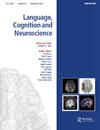手语事件可见性的神经机制
IF 1.8
3区 医学
Q2 AUDIOLOGY & SPEECH-LANGUAGE PATHOLOGY
引用次数: 1
摘要
本文章由计算机程序翻译,如有差异,请以英文原文为准。
Neural mechanisms of event visibility in sign languages
ABSTRACT In unrelated sign languages event structure is reflected in the dynamic form of verbs, and hearing non-signers are known to be able to recognise these visual event structures. This study assessed the time course of neural processing mechanisms in non-signers to examine the pathways for incorporation of physical-perceptual motion features into the linguistic system. In an EEG study, hearing non-signers classified telic/atelic verb signs (two-choice lexical decision task). The ERP effects reflect differences in perceptual processing of verb types (early anterior ERP effects) and integration of perceptual and linguistic processing required by the task (later posterior ERP effects). Non-signers appear to segment signed input into discrete events as they try to map the sign to a linguistic concept. This might indicate the potential pathway for co-optation of perceptual features into the linguistic structure of sign languages.
求助全文
通过发布文献求助,成功后即可免费获取论文全文。
去求助
来源期刊

Language Cognition and Neuroscience
AUDIOLOGY & SPEECH-LANGUAGE PATHOLOGY-BEHAVIORAL SCIENCES
CiteScore
4.50
自引率
13.00%
发文量
70
期刊介绍:
Language, Cognition and Neuroscience (formerly titled Language and Cognitive Processes) publishes high-quality papers taking an interdisciplinary approach to the study of brain and language, and promotes studies that integrate cognitive theoretical accounts of language and its neural bases. We publish both high quality, theoretically-motivated cognitive behavioural studies of language function, and papers which integrate cognitive theoretical accounts of language with its neurobiological foundations.
The study of language function from a cognitive neuroscience perspective has attracted intensive research interest over the last 20 years, and the development of neuroscience methodologies has significantly broadened the empirical scope of all language research. Both hemodynamic imaging and electrophysiological approaches provide new perspectives on the representation and processing of language, and place important constraints on the development of theoretical accounts of language function and its neurobiological context.
 求助内容:
求助内容: 应助结果提醒方式:
应助结果提醒方式:


